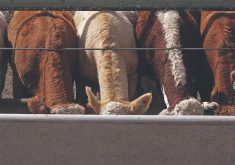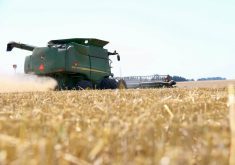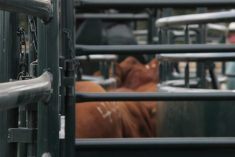Western Canadian feeder cattle prices were $3-$6 per hundredweight (cwt) higher last week as buyers continue to scramble for limited supplies. Recent rains have enhanced pasture conditions across the Prairies and there will be little incentive to market cattle over the next month.
Many cattle buyers are taking a couple of weeks’ holiday after an extremely busy spring and all eyes will be on the U.S. for price discovery and overall market sentiment.
The U.S. Department of Agriculture reported 920-lb. quality steers sold for $203/cwt in Green City, Missouri, breaking the psychological $200/cwt level. Small volumes of “marketing end stragglers” were quoted in the range of $200-$215/cwt landed in southern Alberta feedlot, which makes one wonder where quality yearlings will trade this August. At the same time, small groups under 10 head of poor-quality 500- to 600-lb. steers traded in the range of $220-$230/cwt.
Read Also

U.S. grains: Soybeans hit six-week low as Brazilian harvest looms; corn, wheat sag
Chicago | Reuters – Chicago soybean futures fell to six-week lows on Friday as worries about slowing export demand for…
Alberta packers were buying fed cattle in the range of $151-$153/cwt, steady from seven days earlier. This is about $7/cwt below breakeven 800-lb. steer placements purchased at $215/cwt last week.
During May 2014, there was a year-over-year increase of 2.5 million employed Americans as the unemployment rate continued to hover at 6.3 per cent. There is potential to see another 500,000 Americans working by the end of the year, which will continue to drive disposable income levels higher and support domestic beef consumption. U.S. restaurant sales totaled US$45.6 billion in May, down from a record set in March, but the overall trend remains positive. U.S. wholesale choice beef prices jumped this week by $7, to $237/cwt, which will set a positive tone for fed cattle into July.
Given the demand projections, there is potential for fed cattle to ratchet higher in the fourth quarter of 2014, which should continue to underpin nearby feeder values.
— Jerry Klassen is a commodity market analyst in Winnipeg and maintains an interest in the family feedlot in southern Alberta. He writes an in-depth biweekly commentary, Canadian Feedlot and Cattle Market Analysis, for feedlot operators in Canada. He can be reached by email at [email protected] for questions or comments.















